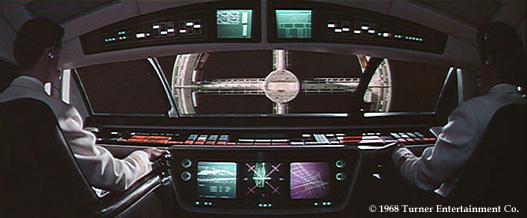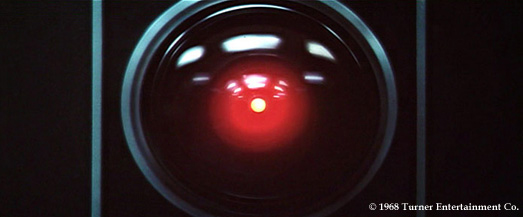|
"A Scientist's Evaluation of 2001," page 2 |
||||||
The second sequence follows a scientist on what, by 2001, is a routine trip to the Moon. The space travel scenes are the most realistic ever put on film. For the most part, well established special-effect techniques are used with a high level of skill: the models are magnificent, the extensive use of mattes--to put moving people inside the models, for example--is flawless, and the variety of techniques used to simulate weightlessness makes it seem quite natural. |
||||||
 |
||||||
Though the trip to the Moon is made to seem routine, the purpose of the trip is quite another matter. A slab identical to the one seen earlier has been found buried near the crater Tycho. The object is the first known evidence of intelligent extraterrestrial beings. That there are probably hundreds of thousands of highly intelligent, nonhumnan cultures in our galaxy is generally agreed by most scientists who are knowledgeable about the evolution of life and the theories of planetary formation. Interstellar exploration by man is, of course, a way off. It will almost certainly be extremely expensive and time-consuming. The nearest star, for example, is some 24 trillion miles away. The planet Jupiter, a mere 465 million miles away at the closest approach, is presented as the outer limit of manned exploration in "2001." Probably the reason man has not yet been contacted, assuming other species in our galaxy are engaged in interstellar exploration, is that we are located in what might best be describe as the galactic backwoods. The sun is well away from the galactic center where the density of stars is much higher. We may be 100 light years or more from our nearest civilized neighbor. Such trips are not undertaken lightly. |
||||||
 |
||||||
In Arthur C. Clarke's 20-year-old story, "The Sentinel" which was the seed from which "2001" sprouted, a glittering, roughly pyramidal object twice as high as a man was found on the moon. In the story, it was destroyed; and, by silencing it, man revealed his presence to the extraterrestrials who placed it there. The consequences were not revealed. In "2001" when sunlight falls on the black slab for the first time since it was buried millions of years before, it transmits a signal in the direction of Jupiter. Some 14 months later, a five-man expedition is on its way to Jupiter to try to determine what was to have received the signal. The spaceship Discovery is largely under the control of an advanced computer, HAL 9000. HAL (Heuristically programmed ALgorithmic computer) might as well be an acronym for Human Almost. Gary Lockwood and Keir Dullea are the two conscious astronauts (three mission members are hibernating to reduce life support requirements). They talk to HAL as they would to another member of the crew. Actually HAL, as vocalized by Douglas Rain, is the most interesting character in the film. Computers equivalent to HAL will very likely be built within the 33 years before 2001. |
||||||
 |
||||||
That Kubrick makes HAL a villain without explaining the malfunction is rather unfortunate. Too many people already fear computers, which are--and will continue to be for the foreseeable future--one of man's most useful tools. |
||||||
|
Introduction / Page 1 / 3 / 4 |
||||||
|
Home / Features / Film Sound / Movie Props / Locations Trivia / Events / Tributes / Recommendations / Blog / About Bibliography / Links / FAQs / Shop / Message Board / Disclaimers / Site Map |
||||||
Please support our site by visiting our affiliates: